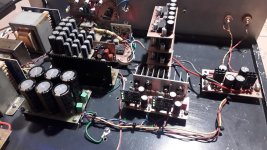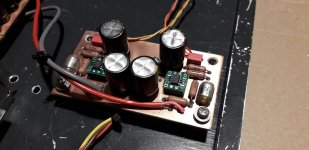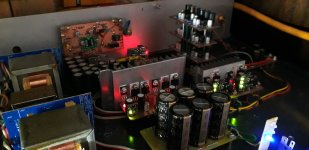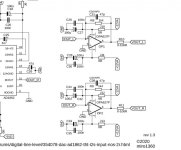Today I finally finalized the rectifier-regulator for the AD811. The output voltage of the regulator is +/-14V, and the input voltage is +/-28V. The rectifier was also refreshed with new capacitors, 6 pcs. 4700u/35V Nichicon KG so that there is literally none ripple at the input of the regulator. That's the beauty of the shunt regulator, with a good CRCRC filter you can literally remove all the ripple from the output of the rectifier.
AD811 now have heat sinks, BGA 12*12mm literally glued to the i.c. and with them the temperature of the AD811 itself is 42.5C which is almost 4C less than without a heat sinks with a lower supply voltage of +/-10V.
I hope to start testing some other op amps this week
AD811 now have heat sinks, BGA 12*12mm literally glued to the i.c. and with them the temperature of the AD811 itself is 42.5C which is almost 4C less than without a heat sinks with a lower supply voltage of +/-10V.
I hope to start testing some other op amps this week
Attachments
Finally to start testing something.
The ADA4625-1 was the first to come to hand only for the reason that it is intended for something else, so this was an opportunity to try it. My intention is to try more than a dozen single and double op amps, but I have less and less free time, a typical problem today.
Operating conditions of the op amps: Vs=+/-14V , Idac=9.6mA pk-pk ,Zdac=250ohm , the output of op amp (Vout=9V pk-pk) is directly connected to the output stage via a 10k potentiometer and there are no capacitors or transformers on the signal path. This will be the case for all op amps in test.
For the ADA4625, the guys from AD say in the DS that it's the best jfet op amp on the market, and I think they're right in this case.
I have to admit that it is good as an I/V, it plays beautifully, a complete surprise. But it's still not like the AD811, it's a bit withdrawn and not as clean and precise, but anyone who hasn't heard the AD811 would be very satisfied with the sound. My friend says that it is similar to the AD797 with the characteristics of sound.
Excellent op amp for I/V stage in any case.
At the end, I will write a long post covering all the op amps in the test.
The ADA4625-1 was the first to come to hand only for the reason that it is intended for something else, so this was an opportunity to try it. My intention is to try more than a dozen single and double op amps, but I have less and less free time, a typical problem today.
Operating conditions of the op amps: Vs=+/-14V , Idac=9.6mA pk-pk ,Zdac=250ohm , the output of op amp (Vout=9V pk-pk) is directly connected to the output stage via a 10k potentiometer and there are no capacitors or transformers on the signal path. This will be the case for all op amps in test.
For the ADA4625, the guys from AD say in the DS that it's the best jfet op amp on the market, and I think they're right in this case.
I have to admit that it is good as an I/V, it plays beautifully, a complete surprise. But it's still not like the AD811, it's a bit withdrawn and not as clean and precise, but anyone who hasn't heard the AD811 would be very satisfied with the sound. My friend says that it is similar to the AD797 with the characteristics of sound.
Excellent op amp for I/V stage in any case.
At the end, I will write a long post covering all the op amps in the test.
Attachments
I ended up opamp rolling with muses05.
It's expensive but worth try.
https://www.nisshinbo-microdevices.co.jp/en/MUSES/index.html
It's expensive but worth try.
https://www.nisshinbo-microdevices.co.jp/en/MUSES/index.html
there are one traditional french brand. Thwy making studio equipment mostly.
They have some discrete OP-ams. Tested by the some german guys with hundred or more other OP-amps
With published results and ranking.
These diskrete OPs has top quality.
Some of them now obsolete to order I think they producing oly 2 models?
BUT they gave chematics, PCBs and complete instructions for present and discountinued.
Also Sound Skulptor has lower the prices for soldered and tested OPs so with that low prices there are no point to making the OPs on Your own?
.
https://www.soundskulptor.com/docs/sk25-schematic-01.pdf
https://www.soundskulptor.com/docs/sk99a-schematic.pdf
https://www.soundskulptor.com/docs/sk99b-schematic.pdf
https://www.soundskulptor.com/docs/sk47-schematic.pdf
https://www.soundskulptor.com/docs/sk25-schematic-03.pdf
https://www.soundskulptor.com/docs/sk99-schematic-03.pdf
.
the kits are just 22.8EU (inclouding VAT), what to say
.
Take a look how good is one of the assembly guide
https://www.soundskulptor.com/docs/sk25-assembly-guide-03.pdf
.
Sorry for the drift in main topic but the are just an informations...
Cheers
.
They have some discrete OP-ams. Tested by the some german guys with hundred or more other OP-amps
With published results and ranking.
These diskrete OPs has top quality.
Some of them now obsolete to order I think they producing oly 2 models?
BUT they gave chematics, PCBs and complete instructions for present and discountinued.
Also Sound Skulptor has lower the prices for soldered and tested OPs so with that low prices there are no point to making the OPs on Your own?
.
https://www.soundskulptor.com/docs/sk25-schematic-01.pdf
https://www.soundskulptor.com/docs/sk99a-schematic.pdf
https://www.soundskulptor.com/docs/sk99b-schematic.pdf
https://www.soundskulptor.com/docs/sk47-schematic.pdf
https://www.soundskulptor.com/docs/sk25-schematic-03.pdf
https://www.soundskulptor.com/docs/sk99-schematic-03.pdf
.
the kits are just 22.8EU (inclouding VAT), what to say
.
Take a look how good is one of the assembly guide
https://www.soundskulptor.com/docs/sk25-assembly-guide-03.pdf
.
Sorry for the drift in main topic but the are just an informations...
Cheers
.
A while ago I made some measurements of PCM1702 I/V stages. The discrete I/V stage by smms73 is easy to build (SMD or TH), measures well and sounds good.
https://www.diyaudio.com/community/threads/dac-i-v-measurements.395738/#post-7266900
https://www.diyaudio.com/community/threads/dac-i-v-measurements.395738/#post-7266900
Hi @bohrok2610 I went trough Your topic and have to say that is very good and informative.
Thanks
BTW
Sergio santos is one of the best designers for IV stages. And inovative too.
I am planning also to build one design, rearranged and changed. Basic idea is that IV taking a place at the - PS branch of the circuit. In tha same time that is negative grid bias for tube amplification stage...
Thanks
BTW
Sergio santos is one of the best designers for IV stages. And inovative too.
I am planning also to build one design, rearranged and changed. Basic idea is that IV taking a place at the - PS branch of the circuit. In tha same time that is negative grid bias for tube amplification stage...
I finally finished upgrading all the essential power supplies-regulators in the DAC. A few days ago the PMD100 got a new shunt regulator only for the interface (pin22, VDD2), eight pieces of PCM1702 also got a new shunt regulator similar to the AD811 analog stage regulator but with a much higher output current (400mA max). All regulators now have ADA4897 and ADA4625-1 op amps in them instead of OPA1641 and ADA4610.
For the first time I tested the ADA4625-1 in a 5V shunt regulator and I must admit that it is much, much better than the OPA1641 at the same position with a 1V reference, the conclusion is that I managed to completely remove the MHz noise from the DAC power lines and analog stage with new op amps and improved power supplies -regulators.
Naturally, all this led to a huge improvement in sound quality, which only confirms my thesis that there is no good DAC without a quality regulators. Unfortunately, the price and the effort invested in these regulators are not small, but they justify the invested funds.
These experiments with power supplies and regulators will greatly facilitate the creation of my new DAC, because I already have developed regulators with excellent characteristics, especially in the MHz range. I think the next candidate will be the PCM1794 with a hybrid analog stage (CFA I/V + tube output).
So far, I still have to test the op amps in this DAC, only AD811 and ADA4625 have been tested, and there are more to come.
For the first time I tested the ADA4625-1 in a 5V shunt regulator and I must admit that it is much, much better than the OPA1641 at the same position with a 1V reference, the conclusion is that I managed to completely remove the MHz noise from the DAC power lines and analog stage with new op amps and improved power supplies -regulators.
Naturally, all this led to a huge improvement in sound quality, which only confirms my thesis that there is no good DAC without a quality regulators. Unfortunately, the price and the effort invested in these regulators are not small, but they justify the invested funds.
These experiments with power supplies and regulators will greatly facilitate the creation of my new DAC, because I already have developed regulators with excellent characteristics, especially in the MHz range. I think the next candidate will be the PCM1794 with a hybrid analog stage (CFA I/V + tube output).
So far, I still have to test the op amps in this DAC, only AD811 and ADA4625 have been tested, and there are more to come.
Attachments
AD811 was my favourite OPAmp for I/V by far... especially with 1704. I used + and - 12V rails and a heatsink on top.... They were running hot but I could hold my finger on the heatsink indefinitely... but the sound... oh so good.
For everything else, I really liked AD8066... but the rails should stay within + and - 12V. Great sounding OPAmp, extended, natural, correct harmonic richness... believable... beautiful.
Re comment about regulators.... power supply contributes 99% to sound quality... everything else a whopping 1%.
For everything else, I really liked AD8066... but the rails should stay within + and - 12V. Great sounding OPAmp, extended, natural, correct harmonic richness... believable... beautiful.
Re comment about regulators.... power supply contributes 99% to sound quality... everything else a whopping 1%.
Almost the same experience. +/12V is about top value regardles of the heatsink volume. I tried +-14V (Jung sch) and it for my opinion was too hot for the long term operation inspired of bigger heatsink on top surface...I used + and - 12V rails and a heatsink on top.... They were running hot but I could hold my finger on the heatsink indefinitely... but the sound... oh so good.
AD8066 is one of my favorite OPs. I used SMD version. Without heatsink I end up with +- 8V cca. I tried (max. from datasheet +-12V) but it was too hot for my op.For everything else, I really liked AD8066... but the rails should stay within + and - 12V. Great sounding OPAmp, extended, natural, correct harmonic richness... believable... beautiful.
Sound is pretty much as You explained.
1704 is a very special DAC IC, with only 2mA of current capability. It works best with close to 0 impedance at Iout; the only OPAmp that can do that is AD811. Have a look at its datasheet... the -IN resistance is unbelievably low - only 14ohms. If implemented as Walter J. suggested, the in-circuit dynamic impedance is below 1 ohm. This is a perfect load impedance that will also ensure very low voltage swings at Iout - therefore keeping the compliance in check. The overall gain can be boosted in a second filter OPAmp stage. With the 1704 dual differential DAC I had, the AD811 I/V was followed by LM6172. The combination was extremely transparent. I also tried AD812 current feedback OPAmp... but the results were not even close to 811.
I played with AD844 and OP861 when I was into Pedja's DACs... but these implementations are different, and the 1541 DAC chip is more capable. I think that to this date, 1541 was the most natural DAC IC I heard.... but 1704 had better resolution, speed, transparency... it was like listening to a super-stretched string that was going to snap any moment. Very invigorating.
AD811 was giving me the best staircase - reconstructed sinewave as well.... perfectly flat holds... really nice to watch on a cro. Even 20kHz reconstructed sinewave looked amazingly good. I could not achieve this with anything else I tried (like... an I/V resistor... followed by a gain stage)
I played with AD844 and OP861 when I was into Pedja's DACs... but these implementations are different, and the 1541 DAC chip is more capable. I think that to this date, 1541 was the most natural DAC IC I heard.... but 1704 had better resolution, speed, transparency... it was like listening to a super-stretched string that was going to snap any moment. Very invigorating.
AD811 was giving me the best staircase - reconstructed sinewave as well.... perfectly flat holds... really nice to watch on a cro. Even 20kHz reconstructed sinewave looked amazingly good. I could not achieve this with anything else I tried (like... an I/V resistor... followed by a gain stage)
Hello Grunf,
I’d like to give AD811 a try in one of my AD1862 MiroDac’s. The board has an integrated opamp circuit for I/V, the difference I see from your/Jung’s AD811 circuit is the addition of R1 (for stability?) and R3, R6, R5 and C5.
At the bare minimum, should I implement R1?
The DAC uses single chip so current output is +/-1mA, not the higher current you get from paralleled chips. But, I use a preamp with gain between the DAC and amplifier. Does R2 and C1 need adjustment from your schematic on Post#1?
I have the choice of using DIP8 or SOIC8 (soldered directly to the pcb, no adapter), which would be best for thermal considerations? Heatsinking for either package is mandatory, correct?
MiroDac I/V section is attached
I’d like to give AD811 a try in one of my AD1862 MiroDac’s. The board has an integrated opamp circuit for I/V, the difference I see from your/Jung’s AD811 circuit is the addition of R1 (for stability?) and R3, R6, R5 and C5.
At the bare minimum, should I implement R1?
The DAC uses single chip so current output is +/-1mA, not the higher current you get from paralleled chips. But, I use a preamp with gain between the DAC and amplifier. Does R2 and C1 need adjustment from your schematic on Post#1?
I have the choice of using DIP8 or SOIC8 (soldered directly to the pcb, no adapter), which would be best for thermal considerations? Heatsinking for either package is mandatory, correct?
MiroDac I/V section is attached
Attachments
I made one IV with these special OP861 amps. Was curious about sound outcome. Everything was OK vith measurements, bias and heat - but the sound was not good at allhow do they compare VS an op861 for the I/V task ?
then I switched, in the same environment, for AD811 and it was different story...
- Home
- Source & Line
- Digital Line Level
- AD811 as I/V stage for current DACs (and test some other op amps including Burson Audio op amps as I/V)





